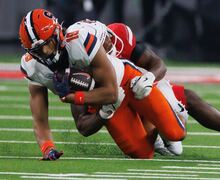How Syracuse’s inconsistent running backs still contribute
Todd Michalek | Staff Photographer
Junior running back Dontae Strickland was a confident slugger in high school and employs the same mindset he used in the batter’s box when trying to block a pass rusher.
Growing up, Dontae Strickland took the baseball field at any position except second base, which he said was too boring. He went from bat boy on his older brother’s team to striking out batters and hitting cleanup in high school. But, after his sophomore year, he put his bat and glove away to focus on football because he liked the physicality of playing on the gridiron.
“People still to this day say, ‘Yo, you should’ve stuck with it,’” Strickland, now a junior, said. “But I’m just like, football is my thing now.”
Strickland’s positional group at SU is veering from expectations, too. Syracuse’s (4-5, 2-3 Atlantic Coast) running backs were supposed to catch up with the rest of Dino Babers’ speedy offense in the head coach’s second season leading the Orange. In its matchup Saturday with Wake Forest (5-4, 2-3 ACC), SU faces a rushing defense that ranks outside the top 100 in the FBS. The Demon Deacons allow 205.6 rushing yards per game, so SU should have opportunities to run.
“I think when everyone talks about Syracuse, the first thing that comes up is the offense and the speed of it,” Wake Forest head coach Dave Clawson said Wednesday on the ACC teleconference. “But they’re running the ball a lot better. I think their offensive line is improved. I think the backs are improved.”
Strickland himself had goals to be SU’s first 1,000-yard rusher since Jerome Smith in 2012. The sophomore one slot beneath Strickland on the depth chart, Moe Neal, had a chance to contend for a chunk of the carries after a promising freshman campaign.
Yet while SU has eclipsed 260 rushing yards twice this season, the running game has been plagued by inconsistency. Last week, it finished with 40 rushing yards attributed to players not named Eric Dungey. With three games to go, Strickland has amassed 423 yards, making 1,000 nearly impossible. Five times in nine games, Neal has seen five or fewer carries. He’s reached double-digits once.
“We’re not that far off with our tailbacks,” Babers said in September.
Not much has changed, but in an offense where short passes dominate the playbook, running backs can contribute by executing other tasks, especially blocking. Picking up an otherwise free blitzer can be the difference in Dungey getting a pass off or not.
There is preparation that readies Strickland to block effectively. In the film room, he learns what moves a defender usually makes. On the field, a low base is essential, he said. But for him, blocking a larger pass-rusher is a mental job, and that’s where Strickland’s baseball background comes into play. For him, it’s like stepping into the batter’s box and seeing a kid who could throw heat 60 feet, six inches away.
“You gotta have confidence saying that this kid is not going to strike you out,” Strickland said. “That kind of carries over to football. In the passing game, me blocking a 6-5 guy, 240 or 250 (pounds), and just being confident I can get the job done.”
At 5-foot-11, 182 pounds, Neal is listed at the same height as Strickland but 25 pounds lighter. That weight difference presents a challenge when Neal pass blocks. Plus, cut blocking, a technique common in the more advanced levels of the sport in which a blocker aims for a defender’s knees, is illegal in high school, when Neal had the ball most of the time anyway. So, there was a learning curve in college.
“It was tough,” Neal said. “It’s more than just diving at somebody’s legs. You gotta have the technique. What to do and when to do it…I still gotta get better at it.”
Although Neal has big-play ability — he broke a 71-yard run against Central Michigan and caught a 52-yard touchdown against Central Connecticut— he’s averaged just over five carries per game and is on pace to fall short of his freshman total of 68 carries. After a strong showing at then-No. 8 Miami late last month in which Neal carried 14 times and scored a touchdown, Babers was asked if Neal had a chance to see similar amounts of action moving forward.
“It’s hard to predict that stuff,” Babers said. “I think the thing about Moe, I’ve always said this, he’s so unselfish. He’s good at a lot of things. He’s kind of like our fire. … I wish I had a team full of Moes. If you have a team full of Moes, you don’t worry about who gets the credit, you normally end up with bowl seasons, everything normally works out.”
Neal said this week that he knows there will be times when his number is not called as often. For someone who was self-labeled as “the man” in high school, as most players at this level were, sharing responsibilities took an adjustment.
But Strickland has encouraged Neal to stay positive. Even though they’re competing for the same carries, the two have developed a bond since Neal first visited SU. Now, when Neal doesn’t get many reps, Strickland is the one telling him to keep his head up until he’s able to get that one touch that sparks a change.
“I’m going to give 110 percent,” Neal said, “and wait my turn and know my time is coming.”
Published on November 11, 2017 at 11:21 am
Contact: jtbloss@syr.edu | @jtbloss





